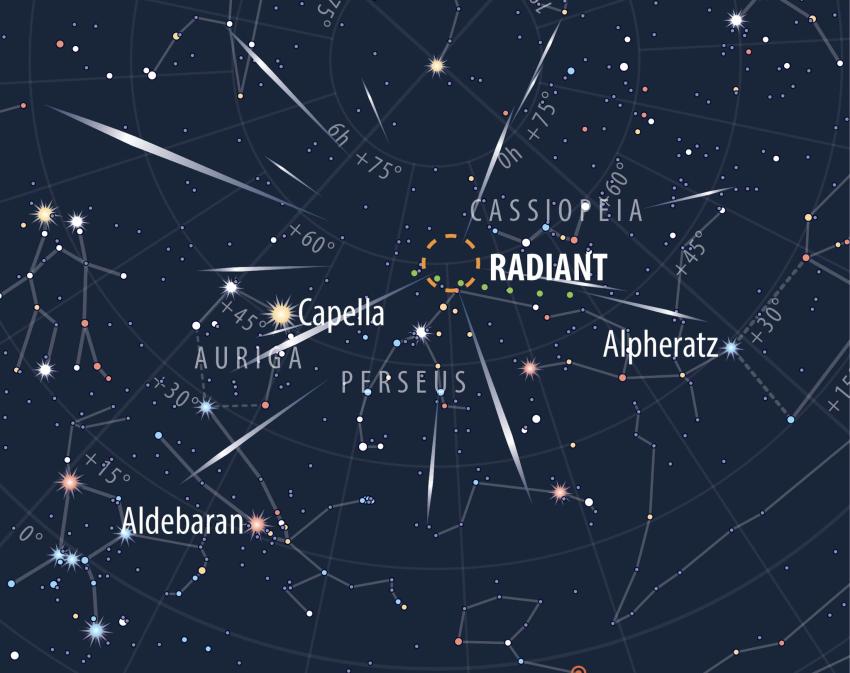The annual Perseid meteor shower will reach its peak on the night of 12-13 August, although skywatchers hoping for a summer spectacular may be left disappointed because of the Moon.
It is always more favourable to try to spot meteors when our lunar satellite is below the horizon or when it is in its crescent phase, but this year's Perseids peak falls three days after a Full Moon, so the brightness may prevent fainter meteors from being visible.
This year's Perseid meteor shower is active between 17 July and 24 August but peaks on Tuesday night into Wednesday. The shower, which is usually one of the most spectacular of the year, is best viewed from the northern hemisphere and will be visible all over the UK, if skies are clear. The ideal time to see it is between midnight and 5.30am.
When conditions are good and there are no clouds, observers can expect to see up to 50 meteors an hour, although that is extremely unlikely this year because of the phase of the Moon.
Those hoping for darker skies should consider trying to see the Perseids on nights between the 16 and 24 August, although meteor activity will be lower.
Meteors (also known as 'shooting stars') are small particles of dust, some as small as grains of sand, entering our atmosphere at high speed. The friction as they pass through causes the air around the meteor to heat up dramatically, resulting in a characteristic brief bright streak of light.
Meteor showers occur when the Earth passes through a clump of debris in space, as our planet moves along its orbit around the Sun. The dust causing the Perseids comes from a comet known as Swift-Tuttle, which last passed near Earth in 1992 and orbits the Sun approximately once every 133 years.
The shower meteors are named for the point in the sky where they appear to originate – the so-called 'radiant' – located in the constellation of Perseus.
In the evening the radiant is lower in the sky, so fewer meteors are seen. Those that do appear are 'Earthgrazers', where the incoming debris particles just skim the top of the Earth's atmosphere and can leave long bright trails.
Later on in the night numbers increase as the radiant rises higher in the sky, with the best view likely to be before 03:00 BST, when the sky will start to brighten before dawn.
Unlike a lot of celestial events, meteor showers are easy to watch and no special equipment is needed, although a reclining chair and a blanket make viewing more comfortable.
Most importantly it will help to be away from artificial light, so observers are advised to avoid built-up areas if possible, and to try to find an unobstructed view of the sky.
If clouds or the Moon do make viewing impossible on the peak night itself, the shower will continue on subsequent nights with likely reduced activity.
ENDS
Media contacts
Sam Tonkin
Royal Astronomical Society
Mob: +44 (0)7802 877 700
Notes for editors
About the Royal Astronomical Society
The Royal Astronomical Society (RAS), founded in 1820, encourages and promotes the study of astronomy, solar-system science, geophysics and closely related branches of science.
The RAS organises scientific meetings, publishes international research and review journals, recognises outstanding achievements by the award of medals and prizes, maintains an extensive library, supports education through grants and outreach activities and represents UK astronomy nationally and internationally. Its more than 4,000 members (Fellows), a third based overseas, include scientific researchers in universities, observatories and laboratories as well as historians of astronomy and others.
The RAS accepts papers for its journals based on the principle of peer review, in which fellow experts on the editorial boards accept the paper as worth considering. The Society issues press releases based on a similar principle, but the organisations and scientists concerned have overall responsibility for their content.
Keep up with the RAS on Instagram, Bluesky, LinkedIn, Facebook and YouTube.


